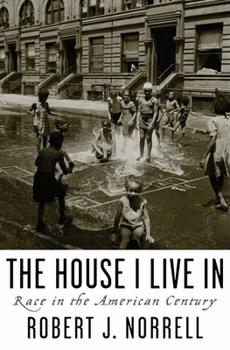The House I Live in: Race in the American Century
Select Format
Select Condition 
Book Overview
In The House I Live In, award-winning historian Robert J. Norrell offers a truly masterful chronicle of American race relations over the last one hundred and fifty years.
This scrupulously fair and insightful narrative--the most ambitious and wide-ranging history of its kind--sheds new light on the ideologies, from white supremacy to black nationalism, that have shaped race relations since the Civil War. For, Norrell argues, it is ideology, more...
Format:Hardcover
Language:English
ISBN:0195073452
ISBN13:9780195073454
Release Date:February 2005
Publisher:Oxford University Press, USA
Length:400 Pages
Weight:1.70 lbs.
Dimensions:1.4" x 9.2" x 6.4"
Customer Reviews
4 ratings
An important, honest work...
Published by Thriftbooks.com User , 17 years ago
To tell the story of race in America as it unfolds over a span of one-hundred years is a daunting enough task for anyone. Yet Robert J. Norrell does so compellingly. This is a thoughtful, disturbingly honest, insightful and comprehensive book. A convergence of influences created the conditions that finally enabled the struggle for civil rights to succeed to the extent that it has. Expanded my understanding considerably while also giving me a visceral sense of the struggle.
Good History of Our Time
Published by Thriftbooks.com User , 19 years ago
This is a dispassionate look at race relations in the United States from the end of the Civil War through the eyes of a professional historian. It has certainly not been a pretty picture all the time. But on the hole these hundred and fifty years offer a fairly positive message. We are a long way from the institutionalized segregated legal system and the Klan of the end of the 1800's. The struggle for racial equality has been long and not always smooth, but the trend line is upward through all of this time. The conclusion reached, I think correctly, is that race relations in this country look more promising than every before. There were two points that I think were not stressed enough in this book. First is the fact that the civil rights movement of the late 60's accomplished such a large number of things, and did so without anywhere the violence that could have happened. It's one of the better things the United States Government has done, ever. Second, the author doesn't mention the role of the Army in race relations. From just after the Civil War when employment was so low among blacks, the Buffalo Soldiers offered jobs, even a career. During the Korean war Truman issued an executive order abolishing segregation in the Army. No fancy laws, no court battles, the Army was not the American society, all it took was one executive order. The end result of this, of course, was Colin Powell. Good History of Our Time.
The (Divided) House I Live In
Published by Thriftbooks.com User , 19 years ago
When I learned that Robert J. Norrell had published a new history of race in the twentieth century, I eagerly ordered a copy. I was not disappointed, for it's a terrific book. Certainly I expected a good read. After all, Norrell's earlier history of Tuskegee, "Reaping the Whirlwind," won the Robert Kennedy Prize in part because of its elegant writing. So, too, "The House I Live In" has plenty of nicely turned phrases and a finely tuned sense of narrative. This is especially evident in the first two thirds of the book, a gripping tale of the familiar events and personalities that led up to the triumph of the Civil Rights movement in 1965. Norrell occasionally departs from the traditional interpretation: Booker T. Washington is treated with sympathy, for example, while the Cold War is credited with delaying integration. This part of "The House I Live In" is a drama of high-minded heroes, despicable villains, bloodied martyrs, and exciting events. If Norrell had chosen to end the book here, then it would have gone down as one of the best syntheses of the struggle for racial justice. But the book takes an abrupt turn in Part Three, "The Meaning of Equality, 1965-2000." Norrell continues his narrative, but the underlying theme of conflicting values now takes center stage. Norrell believes that values are of critical importance and that when they conflict, America has divided and suffered. He rightly notes that the tragedies of the late twentieth century arose when one ideal was purchased by destroying another: when quotas promising to provide one race more opportunities excluded qualified applicants of another race, or when busing aiming to give some a better education destroyed others' sense of community. Part Three will bring out the detractors. I have in mind two sorts of historians especially: those content to end their books with the triumphal sense of the 1960s and those compelled to indict the responsible parties who stood in the way of a perfectly color-blind society. By contrast "The House I Live In," at once more disturbing and yet more accurate, portrays an America divided by principle, an America searching for solutions, an America where moral progress cannot be taken for granted. And therein lies this book's real strength.
The House we can all live in
Published by Thriftbooks.com User , 19 years ago
The House I Live In is a history of race relations in "the American Century." I found Dr. Norrell's book to be fascinating, well written and surprisingly objective. Dr. Norrell gets very deeply into this problem that has baffled politicians and academics in a way that is interesting to read; and, at the same time, he offers observations that seem genuine, in contrast to most writers, who seem to have a pre-determined objective. If you have an interest in history or just want to read an interesting book, I recommend this book.




